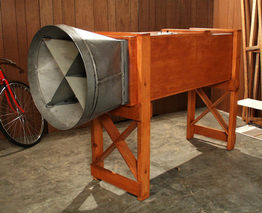Objective
Students will construct and use a simple device to demonstrate Bernoulli’s principle and relate it to the “lift” of an airplane.
Students will:
● Be able to construct a device with a straw, tape and paperclips.
● Explore the effects of blowing air through the straw and the movement of a ping pong ball in reaction to the fast moving air.
Materials
Students will need: 1 flexible bend straw, 3 large paperclips, 1 ping pong ball, Tape, and a Copy of recording sheet Teachers will need: Whiteboard/markers and a Hair dryer.
Procedure
1. Discuss the term “levitate” (float in the air). You may even want to talk about magicians that can make objects or even people appear to levitate. Can students cite any examples of something they have seen levitate? Can they explain why? Show them a ping pong ball and ask if anyone can make it levitate. If so, let them demonstrate.
2. Did the Wright brothers’ kites or gliders levitate? This question could be used to create interesting dialogue about levitation, gliding, and actual powered flight.
3. Ask students what they think “lift” means when talking about levitation or flying?
4. Give each student a straw, ping pong ball and recording sheet. Give them a few minutes to see if they can make the ball float. Many students will be successful but the balls will likely go flying all over the room! It is ok, because they will be engaged! Have students discuss within their group the first question and write down problems they may be experiencing.
5. Give each student 3 paper clips and scotch tape. Ask if they can incorporate these materials to help them. Can students use these materials in any way to help them levitate the ball or to keep the balls from falling when students quit blowing through the straw? Paper clips can be bent if needed. Before students start, have them answer the second question.
6. Observe their attempts giving feedback and encouragement. Remind them that the Wright brothers worked for many years before they were successful. They persevered through many failures before they were successful. You could discuss the fact that even though the Wright brothers worked mainly between themselves, they did reach out to others for help and suggestions. Encourage those that might be having difficulty to look at other models within the classroom to see if they can get ideas. Students may think that is “copying” or “cheating” but remind them that the Wright brothers took ideas of others and expounded on those to create even better models which eventually led up to the successful flight.
7. After giving students ample time to create and explore, have them share their “inventions” with the class. Have them draw their inventions in the space provided on the recording sheet. Pose these questions and if time allows (or on another day) try them out. Does it make a difference if you blow harder or softer through the straw? What if the straw was shorter? What if you put 2 straws together? What if you used a fatter or thinner straw? What might happen if you blow through a paper towel roll? Is there another source that could be used to levitate the ball? Students may come up with a hair dryer or fan.
8. Using a hair dryer, demonstrate Bernoulli’s principle using a ping pong ball. Show that the hair dryer can be pointed at different angles and the ball will still stay within the stream of air. Does the hair dryer remind them of anything that the Wright brothers used? (wind tunnel and strong ocean winds) Will the hair dryer work to “levitate” other objects such as a pencil, piece of paper, popsicle stick, inflated balloon? If time allows, try these out.
9. Explain what Bernoulli’s principle is. (The video suggested in the “Before the Lesson” offers a kid friendly explanation.) How is Bernoulli’s principle seen in the real world? Relate this to the Wright brothers and their wind tunnel testing of over 200 different wing shapes in order to get the most lift. Relate this back to why the brothers decided to experiment with their flyers in Kitty Hawk. (wind). Was the prediction about lift that students made earlier in the lesson correct?
Reflexive Analysis
This resource informs a bit of how the NPS approaches education around the Wright brothers through activities off site. Not only is this lesson plan useful in considering the kinds of demonstrations that are easy to carry out and what kind of information is prioritized, but to help me start thinking about problems that exist in disseminating information in other places. I will consider this in a divergent circumstance matrix as an axis, on site (at the park) — off site, or stationary — mobile. Some problems are dependent on their surroundings and the historical value of the sites themselves. While other ideas can come from making the information mobile.
Sources
Adventure Wing/Virtual Hangar/1901 Wright Wind Tunnel. 1901 Wright Wind Tunnel. (n.d.). https://www.wright-brothers.org/Adventure_Wing/Hangar/1901_Wind_Tunnel/1901_Wind_Tunnel.htm
U.S. Department of the Interior. (n.d.-a). Levitating Ping Pong Balls. National Parks Service. https://www.nps.gov/teachers/classrooms/levitating-ping-pong-balls.htm




